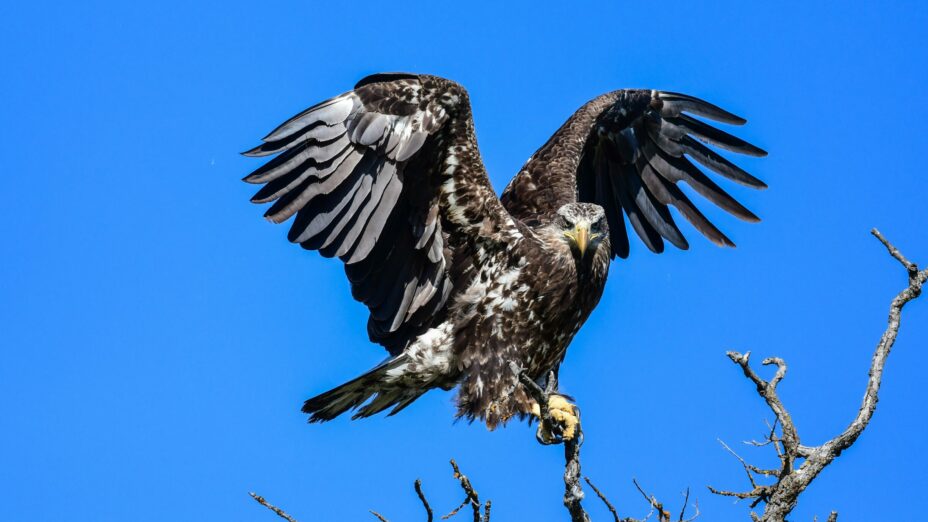
The northern Diablo Range is home to a large golden eagle population; in fact it’s the site of highest concentration of nesting golden eagles on the planet.
However, golden eagles aren’t the only mighty eagles one can find soaring over the vast landscapes of the Diablo Range.
Look up and you could catch a glimpse of our national birds, bald eagles, which can be found up and down the Diablo Range, and throughout most of North America.

A bald eagle spreads its wings in the northern Diablo Range. Bald eagles are one of North Americas largest birds, with a wingspan of 6.5 to eight feet! Photo by Sean Burke
These extraordinary birds are both a symbol of the United States and one of the Diablo Range’s most iconic apex predators.
Historically, many bald eagles in California followed the San Joaquin River, hunting fish throughout central California’s longest river, which runs parallel to the Diablo Range.
Despite bald eagles’ symbolic importance, they didn’t officially become our national bird until 2024, when President Biden signed a law to make them so.
An American Conservation Victory

Bald eagle nest in the northern Diablo Range. Bald eagles build some of the largest nests of any bird, with a typical diameter of five to six feet! Photo by Sean Burke
For many years, bald eagles in the lower 48 states were an increasingly rare sight. Because of a cascade of stressors including overhunting, habitat loss, and DDT, our national birds were once at risk of extinction.
In 1963, their total numbers bottomed out at 417 breeding pairs.
Fortunately, bald eagles are a famous conservation success story. In 1973, bald eagles were listed under the Endangered Species Act.
Protections afforded by the Bald and Golden Eagle Protection Act and the Endangered Species Act helped accelerate the bald eagles’ recovery, along with captive breeding programs and the eventual banning of DDT.

A bald eagle in the northern Diablo Range. These mighty raptors can live for decades in the wild. Photo by Sean Burke
As a result, in 2007, bald eagles were officially removed from the federal list of threatened and endangered species.
And in recent years, bald eagle populations have sharply risen. From 2009 to 2020, bald eagle populations in the lower 48 states quadrupled, reaching 71,400 nesting pairs!
Now, protections afforded by the Bald and Golden Eagle Protection Act help us conserve more of their Diablo Range habitat.

A juvenile bald eagle spotted at one of our 2024 BioBlitzes. Photo by Sean Burke
Save Mount Diablo has been working to preserve land with potential nesting trees, including large heritage oaks and the bald eagles’ preferred choice, the gray pine.
The bald eagles’ story is a great example of what we can do to protect wildlife populations in the Diablo Range and through the United States, and of how these can recover and flourish with the right support.
When the impacts of development and biodiversity loss are more evident than ever before, it’s important to look at success stories like that of the bald eagles to remind us that nature can recover, if we give it a chance.
Bald Eagles and Us

A bald eagle perches near a lake in the northern Diablo Range. Bald eagles breeding habitat in California is often near reservoirs, lakes, and rivers. Photo by Sean Burke
Eagle-eyed visitors can find bald eagles near large bodies of water within the Diablo Range.
Parts of the Diablo Range such as Del Valle, Los Vaqueros, and Pacheco Reservoir are great places to go if you want a good chance of spotting one.

Bald eagle nest at Pacheco Reservoir. Photo by Scott Hein
Spotting bald eagles in the wild is a special moment, a reminder of the grandness of nature and of our connection to it.
“Through hands on conversation work, with human beings helping those animals, we’re now seeing the nation’s bird in more locations than we ever saw them before,” says Save Mount Diablo Land Programs Director Sean Burke.
“They’re such a symbol of patriotism, and it really inspires me to see them flying freely in the Diablo Range.”

A pair of bald eagles perched over their northern Diablo Range habitat. Though bald eagles can eat a variety of food, they eat fish as the centerpiece of their diet. Photo by Sean Burke
Land is the most important thing we have, and it is our responsibility to future generations —and to ourselves—to protect and steward it.
We are a part of the land, but it doesn’t have a voice. It needs us to speak us for it, especially when a wide swath of protections like the Endangered Species Act are at risk of or are currently being rolled back.

A bald eagle swoops through the air in the northern Diablo Range. Every year, hundreds of bald eagles fly south to California for the winter. Many of them stay in the Diablo Range. Photo by Sean Burke
In these challenging times, we can look to the sky and the wonders it can bring.
When we are feeling hopeless or disconnected from the world, an awe-inspiring experience like spotting a bald eagle in the wild can reground and reconnect us with nature, giving us the will to protect it, something that is more vital now than ever before.

